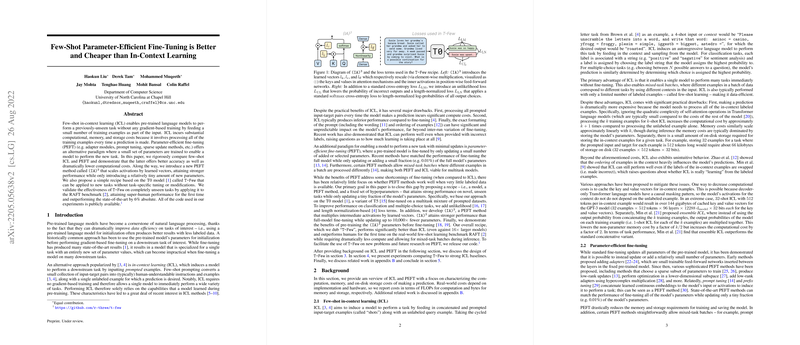Few-Shot Parameter-Efficient Fine-Tuning is Better and Cheaper than In-Context Learning
The paper "Few-Shot Parameter-Efficient Fine-Tuning is Better and Cheaper than In-Context Learning" provides a comprehensive analysis of parameter-efficient fine-tuning (PEFT) methods, establishing their effectiveness compared to in-context learning (ICL) for few-shot learning tasks in LLMs.
Key Contributions
The paper introduces a new PEFT method, dubbed "Infused Adapter by Inhibiting and Amplifying Inner Activations" (IA3), which applies element-wise multiplication to model activations using learned vectors. This approach remains compatible with mixed-task batches and incurs minimal computational overhead. The authors validate IA3's superior performance on various datasets compared to existing methods such as BitFit, Adapters, Compacter, and others.
Numerical Results and Analysis
The authors present compelling numerical evidence demonstrating that PEFT with IA3 yields higher accuracy over ICL, even when tested against state-of-the-art ICL models like GPT-3. For instance, IA3 achieves a 6% higher accuracy than GPT-3's largest variant while significantly reducing computational costs. The paper also benchmarks IA3 on the RAFT dataset, achieving super-human performance and outperforming existing methods by over 6%.
Methodological Insights
The paper emphasizes computational efficiency by estimating the FLOPs for each method, showing that IA3 offers more than a 1,000-fold reduction in inference FLOPs compared to GPT-3 ICL. The storage costs are also modest, requiring only a few megabytes for the additional parameters.
Furthermore, the authors introduce two auxiliary loss functions: unlikelihood loss and length-normalized cross-entropy loss, which enhance PEFT performance on classification tasks. These additions mitigate common issues with ICL, such as sensitivity to example order and prompt formatting.
Implications for Future Research
This paper not only establishes the superiority of PEFT over ICL but also opens avenues for further exploration in parameter-efficient methods within AI. The results suggest the potential applicability of IA3 across diverse tasks and model architectures. Future work may consider extending these techniques to generative tasks and exploring the integration of PEFT with small-scale models for broader accessibility.
In conclusion, the paper makes a significant contribution to the field by offering an efficient and effective alternative to traditional in-context learning methods for few-shot learning, providing insights into the practical considerations of adopting parameter-efficient architectures in LLMs.
